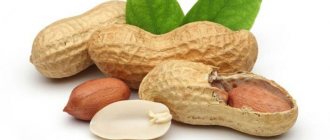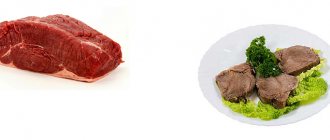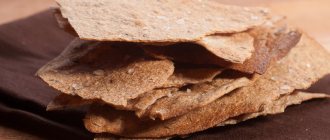The taste of Georgian cheeses will not leave indifferent either the sophisticated gourmet or the average person. The absolute leader (in terms of sales rates and popularity among the population) is Suluguni. It is best to buy cheese at the market, not in a supermarket, in order to feel the real Georgian spirit, and not the industrial scale of the cheese factory. Ideally, the cheese should be prepared the day before: this can be easily determined by the color of the head (the lighter, the fresher).
Cheese is eaten as an appetizer, main course, heat-treated, fried and even pickled. What really lies behind the familiar taste and is it safe to diversify your diet with cheese?
What is suluguni cheese
Suluguni is one of the types of traditional brine cheese, and its homeland is considered to be the region of Samegrelo in Western Georgia. In its own country, the product has won popular love, becoming a symbol of the mountainous region, where not a single feast takes place without it. Here it is added to almost all traditional dishes: from khachapuri to khinkali.
The product has a bright, unadulterated fermented milk taste, a spicy aroma and a compacted structure that retains its springy shape. Classic suluguni has a snow-white or slightly yellowish tint, which evenly covers the entire surface of the cheese slices. During formation, voids and “eyes” may appear in them, but only of an asymmetrical shape.
There are not so many varieties of the product. Lightly salted Georgian suluguni is considered the softest, and yellow cheese made from buffalo milk is considered the rarest. Smoked suluguni is recognized as popular in Russia, with a subtle smoky aroma and a brown-red crust. In supermarkets it is often sold under the guise of “pigtail” cheese.
In home production, to add piquancy to the product, housewives often add a variety of seasonings to cheese: paprika, herbs, mint, mushrooms. To extend the shelf life of this product, they can infuse it with the aroma of mulberry or alder firewood by hanging the product over the hearth of the stove.
Originally from Georgia: where and how the name “Suluguni” appeared, what does it mean
The historical birthplace of cheese is considered to be the region of Samegrelo, located on the eastern Black Sea coast in Western Georgia. But the appearance of its name remains a mystery to this day. However, scientists have three likely explanations for the etymological origin of the word:
- In the Megrelian dialect, Suluguni originally sounded like “Selegin”. This word could be formed from the roots “sele” and “gin” (“knead” and “cattle”), which are a reference to the main component of the cheese: the milk for it was taken from cows or buffaloes.
- In the Digor dialect of the Ossetian language there is a word “sulugun”, meaning whey. Philologist T. A. Guriev believes that the prefix “gun” in a word can indicate a certain affiliation with something and dependence on it. Then “suluguni” can be literally translated as “made from whey.”
- Georgian scientists claim that the word “suluguni” appeared by merging two other word forms: “suli” and “guli” (“soul” and “heart”). This version is considered the most popular in Mingrelian folk culture, but is the most unlikely among scientists.
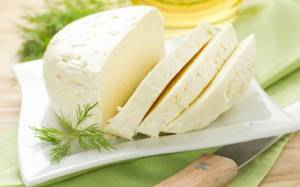
Fat content, calorie content and composition of cheese
Suluguni is one of the lowest calorie cheeses. Its energy value per 100 g of product is only 290 kcal, which is a small amount when compared with other popular types of cheese:
| Name of cheese | Kcal per 100 g of product |
| Mascarpone | 412 kcal |
| Parmesan | 392 kcal |
| Russian | 363 kcal |
| Dutch | 352 kcal |
| Suluguni | 290 kcal |
Cheese contains essential micro- and macroelements, vitamins and a significant amount of protein:
| 100 g of product contains: | |
| Squirrels | 20.5 g |
| Fats | 22 g |
| Carbohydrates | 0.4 g |
| Water | 51.9 g |
| Vitamins | A, B1, B2, B3, C, D, E, PP |
| Microelements | K, Ca, Na, S, P |
| Macronutrients | Fe |
How is suluguni made?

The main ingredient for cheese is pasteurized cow or buffalo milk (a mixture of the first and second types in equal proportions is allowed). The acidity of mature cow's milk is 20-21°T (Turner degree is a unit of measurement for the acidity level of dairy products), and when mixed with buffalo it reaches 22-25°T. In the traditional format, the cheese is made from milk and a natural rennet starter. Abomasum is part of the stomach of cattle, the so-called glandular stomach. The traditional option involves going through all the cooking processes manually, without the help of any improvised means.
In modern realities, when cheese production must be calculated down to seconds, traditional methods have been replaced by innovative and technological ones. Calcium chloride and a starter culture based on special bacteria (consists of strains of flavor-forming and lactic acid streptococci) are added to pasteurized milk. The resulting mixture is heated to a temperature of 35°C, then pepsin (or rennet starter) is introduced to allow the milk to coagulate. After initial processing, large clumps of cheese mass are obtained, which are divided into small cubes of 6-10 millimeters. The cheese is allowed to “rest” for 5-10 minutes, after which it is dried (10-20 minutes) and the next stage of processing begins.
The cheese mass is exposed to high temperatures a second time. This time the product is heated to 34-37°C for 15 minutes. After this, the cheddarization process occurs.
Cheddarization is the process of changing the cheese mass. The product is exposed to lactic acid until it obtains a fibrous layered structure and a dense elastic consistency. Small cheese clots stick together into a single layer and, as a result of increased lactic acid process, turn into the cheese that we see on grocery shelves.
After cheddarization, the suluguni is melted, about 80% of the whey is removed, a single layer is re-formed and pressed. The pressed mass is left at a temperature of 28-32°C. Repeated cheddarization occurs, and then ripening of the finished cheese occurs. The average ripening time for suluguni is 3 hours [1].
After lengthy manipulations, the cheese is squeezed out of moisture, given the required shape (braid, layer, slices, whole piece), packaged in a container filled with acidic whey brine and left for several hours. Some cheeses are smoked, fried, re-boiled, or marinated in special brines/spices to enhance the flavor. The finished product is vacuum packed and sent to distribution points.
What are the benefits of suluguni
The product contains a huge amount of calcium and phosphorus, which strengthen the human skeletal system and inhibit the development of diseases of the musculoskeletal system. If you eat Georgian pickled cheese for a long time, a cumulative effect is created. Thanks to this, positive changes occur in the body:
- Blood circulation throughout the body improves;
- The walls of blood vessels are strengthened;
- The digestion process is normalized;
- Metabolism accelerates;
- The healthy condition of the skin is restored (inflammation, acne, allergic rashes go away).
The high salt content in this cheese also helps maintain salt balance in the body, normalizes digestion and shapes the functioning of nerve impulses. Thanks to it, oxygen, fluids and nutrients enter the cells, and muscle tone is maintained. And the right amount of salt in the body is necessary to combat the development of depression and disorders of the cardiovascular system.
For those losing weight
Suluguni is not prohibited for those who follow a diet. It copes well with the feeling of hunger while on a diet and instantly restores energy. It can be used as a separate dish or together with a slice of rye bread, herbs and vegetables.
For those losing weight, such a meal will be useful in many ways, because it:
- Will not cause heaviness in the stomach;
- Will split quickly;
- Will stimulate acceleration of metabolism.

For pregnant women
The most important thing for pregnant women is a balanced diet, including foods with a full range of vitamins and minerals, which are present in large quantities in suluguni. The portions of cheese allowed by your doctor and nutritionist will have a positive impact on the well-being of the expectant mother and on the development of her child. For the most part, this applies to pregnant women with anemia, problems with appetite, and poor weight gain.
!!! The B vitamins contained in the product are the key to the growth and development of the baby.
For nursing women
Nursing mothers who eat suluguni can recover from postpartum depression faster and have more strength and energy. However, the salt in the product can negatively affect lactation, as it affects the water balance of the whole body. In addition, cheese can have a negative effect on the baby’s digestion if he is allergic to milk protein. Therefore, you should eat pickled cheese carefully, starting with small portions and monitoring the baby’s reaction.
The mother can try the first piece after the first month of the baby’s life, and the proportion of fat in the product should not exceed 30%. It is recommended to eat fattier varieties no earlier than 2-3 months. Throughout the entire lactation period, the daily portion of suluguni should be no more than 30-50 grams.
For children
Suluguni cheese can be introduced into children's diets from the age of three. It will be useful for kids for several reasons. It contains:
- Ten times more calcium than other fermented milk products;
- A large amount of vitamins A and B2, which regulate immunity;
- Fermented proteins that are perfectly absorbed by young organisms.
However, it is worth remembering that it also contains a lot of salt, so cheese is not suitable for frequent consumption by children. To reduce the excessive saltiness of the product, you can soak it in a cold liquid: water or milk before serving.
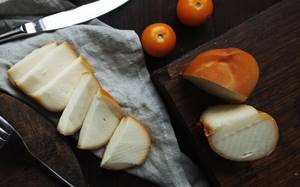
Application area
Suluguni cheese is the main ingredient of many dishes prepared in Georgia. It gives them an unusual taste and enhances their piquancy. It is often used to improve food that is too bland. Sometimes used as fillings for various flatbreads.

Sometimes the delicacy is eaten just like that, with or without bread. Use to sprinkle on salad. Craftsmen bake it in a pie, thereby making the dish unusual and bright. There are no restrictions - only imagination. The Georgian product is good in any form and with any cooking method.
How can eating suluguni harm you? Should you eat it fried?
Cheese is a salty and fatty product, the consumption of which in unlimited quantities can be fraught with serious trouble. Doctors and nutritionists have identified several disadvantages of this product and were able to analyze what consequences they could lead to:
| Cons of the product | Consequences of using the product |
| High calorie content | The appearance of excess weight |
| High fat content | The appearance of cholesterol plaques on the walls of blood vessels |
| High salt content | May irritate the gastrointestinal tract, cause swelling, slow down lymph flow |
| Lactose | Allergies to products in people with intolerance |
| Animal enzyme | Overeating, excess weight gain |
!!!When cooked, suluguni begins to produce sugar and harmful toxins, increasing the calorie content of the product, so it is not recommended to bake or fry the cheese often. And people with gastrointestinal disorders should completely avoid the smoked version.
Many manufacturers turn out to be not very decent and can do more harm than good with their products. Some cheeses made by irresponsible companies may contain hormones, antibiotics and pus. Chemicals consumed in large quantities can cause:
- Osteoporosis;
- Hormonal imbalances;
- Cancerous tumor;
- Malfunctions of the gastrointestinal tract;
- Intestinal microflora disorders.
But don’t be upset, because moderate consumption of cheese 1-2 times a week will not harm the body. At the same time, it is important to choose a reputable manufacturer, monitor the quality of the product, and also correctly calculate the consumed amount of proteins, fats and carbohydrates, drink a lot of water, eat vegetables and fruits.
Calorie content of suluguni per 100 grams
This parameter directly depends on what technology was used for cooking and smoking. The homemade product contains about 283 kcal.
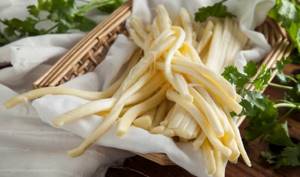
Fried is not only the most harmful, but also the most high-calorie, with high fat content. The above volume accounts for 376 kcal. Finally, the calorie content per 100 grams of smoked suluguni cheese, sold in the store, contains 225 kilocalories.
How to identify a good pickled cheese
High-quality cheese can be bought in large stores and at the rural market. However, you can also run into spoiled or unsuitable suluguni in any of these places. It is important to learn how to correctly identify a first-class product by its external features.
By label and packaging
In stores, this Georgian cheese is sold in sealed packaging with a label that displays up-to-date information from a certified manufacturer. It must be studied to be sure of the quality of the product. The label must contain the following information:
- About the manufacturing company and its details;
- About the timing of implementation;
- Composition and calorie content of the product.
Vacuum packaging must not have any flaws or damage. Also, upon your request, the seller must present a certificate confirming the quality of the product. If it is missing, then it is better not to purchase such cheese.
By appearance of cheese, brine
The color of high-quality suluguni can vary from white to yellowish (depending on the milk, its fat content and the presence of possible additional ingredients). There should be no defects on the surface of the cheese other than small uneven bulges formed by exposure to air.
Suluguni must be in brine, which guarantees compliance with the manufacturing rules and protection of the cheese product. If you purchase suluguni by weight, carefully inspect the surface. It should be damp, but not slippery, since mucus is direct evidence of manufacturing irregularities.
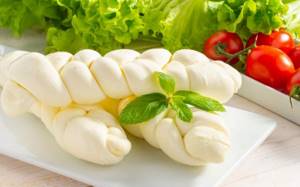
By shape and thickness
The shape of the suluguni is acquired during manufacturing. It does not affect the quality of the product in any way, and therefore can be anything. It’s better to pay attention to the thickness of the cheese head: the greater the thickness, the better the quality of the salting.
By consistency
The texture of cheese can be different: layered, elastic and even slightly rubbery are acceptable. However, it should not crumble in your mouth. Its structure should be quite elastic, but at the same time dense. To check the consistency of the cheese, just press it lightly with your fingers. A good suluguni will spring back and fill with liquid whey.
By taste and smell
By purchasing this type of Georgian cheese at the market, you have the opportunity not only to inspect and smell, but also to taste the cheese. A quality product will taste a little salty, as well as tender and creamy. Aged suluguni may taste moderately bitter. The smell of the cheese should have a faint sour milk aroma.
Taste and color
Dense, elastic, elastic, layered cheese without a white or slightly yellowish rind has a pleasant sourish-salty taste. The preparation technology involves placing the product in a serpyanka mesh, so traces of it may remain on the surface of the head with a diameter of up to 20 cm and a height of 5-6 cm. There may not be “eyes” on the cheese. Thanks to a special careful cheddarization (melting) procedure, the cheese has a layered structure. If suluguni is not very salty, it tastes better, but has a shorter shelf life.

This type of cheese is very plastic; a properly prepared product should create a feeling of “springiness” on the teeth and crumble.
Suluguni lends itself well to the smoking process. It acquires a beautiful brownish tint and a golden brown crust. The aroma of smoked suluguni cannot be confused with any other. A slightly salty taste and rich elastic consistency are characteristic of all types of cheese of the brine group.
On a note. An incomparable, interesting taste appears in suluguni if it is lightly fried in flour and sprinkled with sesame seeds.
How to cook suluguni at home (step-by-step video recipe)
Making suluguni is a complex process consisting of several stages, which not everyone can do. There are two main stages of home cheese production:
- Rennet, which promotes coagulation, is taken and added to warm milk. After which Imeretian cheese is made from it, which looks like feta cheese. The resulting lump of cheese is pressed and left for 5-6 hours, so that during this time it can “reach”.
- The prepared cheese is cut into medium-sized pieces, after which it is placed in water or hot whey, where it is collected in a melted state and formed according to the required parameters. The cheese is then immersed in brine to be soaked in salt. The resulting cheese discs are served within two days or aged for a month or more.
A detailed guide to making suluguni cheese at home is in the video below.
Main Ingredients
To understand how many calories are in Suluguni cheese, you need to determine what and in what proportions are required for its preparation. The main raw material that determines the main properties is milk. Moreover, in order to make 1 kilogram of a delicious smoked product, you will need 10 liters of milk.
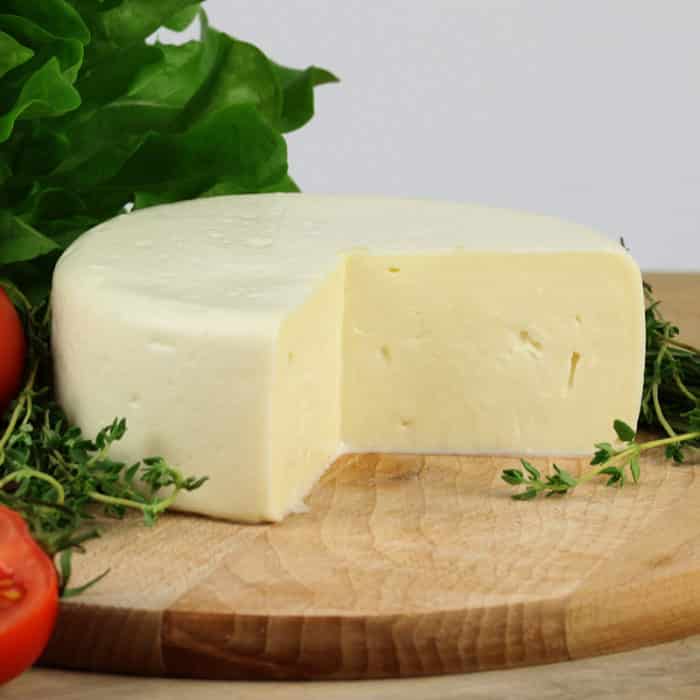
It acts not only as the basis, but also as a catalyst for all reactions, so the color of Suluguni cheese depends on what kind of milk was used for cooking. Traditionally, sheep or goat is used. However, there are options made from cow's and even buffalo's milk.
What and how do they eat it?
Suluguni is a universal product that forms the basis of several Georgian dishes. Khachapuri, vegetable rolls, achma, penovani, Georgian rolls and khinkali are made from this cheese, beloved by the Caucasian peoples. It is also used in salads, casseroles, kebabs and goes well with Georgian wine.
!!! Most often, suluguni is eaten with thin lavash or warm bread. Such a sandwich, seasoned with fresh herbs, perfectly fills you up and relieves hunger.
Use of the ingredient in cooking
Culinary experts call suluguni a universal cheese. It goes well with both vegetables or fruits and meat/fish ingredients. Suluguni creates the best flavor combinations with:
- radishes;
- olives;
- cucumbers;
- beans;
- red onion;
- lean meats;
- fish;
- mustard;
- sour cream;
- balsamic vinegar.

Cheese is served in all possible forms: raw, smoked, baked, fried. By changing the type of heat treatment of cheese, you can radically change the flavor palette of the entire dish. The most popular dish with suluguni is khachapuri. This is a traditional Georgian flatbread with cheese filling. The product can also be added to salads, appetizers, and served in addition to first and second courses.
What dishes can be made with suluguni cheese: recipes
With suluguni you can prepare any dish that requires the presence of stretchy and salty cheese. Just add grated or chopped suluguni to your usual khachapuri, puff pastry pies, pizza, baked vegetables with champignons. It will give the dish a spicy and unusual taste.
Several original recipes with suluguni cheese can be viewed below and prepared now for breakfast or dinner.
How to make mamalyga with suluguni
One of the favorite dishes of the residents of Guria and Megrelia, which is simply prepared. The cheese must be cut into slices, and then “buried” them in hot and thick corn porridge. Soon the cheese will melt, creating a wonderful aroma in the house. Frozen hominy is usually served to the table, steeped for several minutes.
Achma with Suluguni – layered delicacies
Achma is a dish baked in the oven. Its base consists of thin flatbreads and the filling is cheese. Usually the dough is boiled in boiling water in advance and then laid out on a baking sheet. It is covered with grated suluguni and herbs on top, and then the dough is laid out again. This way you should get at least 5 layers.
The last of them is greased with yolk or filled with an egg-kefir mixture, sprinkled with the remaining cheese, after which the dish is sent to the oven for 20-30 minutes. It is served hot to the table while the suluguni is still stretching.
How to cook a delicious homemade omelette with suluguni
The usual egg dish can be changed by adding 20-30 grams of suluguni to it. To do this, you need to cut the Georgian cheese into small pieces and sprinkle them on the egg mixture in the frying pan. When the suluguni has melted, the omelette should be placed on a plate and eaten immediately while the dish is hot and the cheese is stretching.
Also on our portal you will find:
Recipe for making tender homemade khachapuri with suluguni and mozzarella cheeses
Georgian cuisine: how to cook traditional Imeretian khachapuri
Cheese pudding “Kolobok” - prepare a delicious, hearty hot breakfast
How to properly store Georgian and other types of cheese at home
What budget cheese can replace Parmesan
***
No matter what dish suluguni appears in, it always brings with it a touch of spice and the aroma of mountain air, causing real gastronomic delight. Try a snow-white slice of Georgian traditional cheese, enjoy its delicate sunny taste and you will definitely love it.
Smoked and toasted
Smoked suluguni was invented so that the prepared product could be consumed for a long time . During the smoking process over a fireplace, the cheese appears to be preserved. The smoked product can be stored for a long time. If suluguni is well dried, then after smoking its shelf life will be several months.
Extracted cheeses melt well, so the variety is suitable for making open pies and pizzas. You can fry it like halloumi . To do this, the cheese is cut into portions, rolled in spices or corn flour and fried in a frying pan with a small amount of vegetable oil.
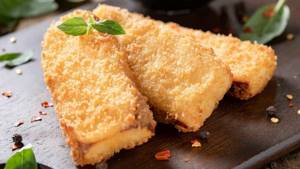
Suluguni production technology
The peculiarity of this cheese is its structure, which is distinguished by elasticity and density. Therefore, the product is manufactured using a special technology, consisting of the following steps:
- Adding 0.7-1.2% starter to milk.
- Coagulation of milk at a temperature of 34–37°C until an elastic clot is formed.
- Mechanical or manual processing of the clot.
- Long-term setting of grain with slow mixing.
- Folding the settled grain into a layer and pressing with a light load.
- Place the finished mass in the whey at a temperature of 28–32°C for 3–5 hours.
- Heating and stretching the resulting cheese.
- Formation of the finished product.
We recommend reading: What are the benefits of goat cheese
After suluguni, labeling, transportation and assessment of its quality await, depending on the ingredients used, compliance with the temperature regime and the creation of storage conditions.
What to replace
What can replace suluguni? This question occupies lovers of Georgian pickled cheese. Unsmoked Armenian chechil, fresh Italian mozzarella and suluguni are very similar to each other. If we are not talking about haute cuisine, then one variety is completely replaced by another.
In addition, real suluguni and mozzarella are similar in that they are traditionally prepared from buffalo milk. However, the classic product is difficult to find today, and it costs much more. Cheeses made from cow's milk predominate on sale.
Today, something else is more important - the correct technology for cheese production. If the recipe is followed, the cheese turns out to be of high quality. Unfortunately, it is not always possible to buy one. It should be taken into account that many fakes have appeared on the shelves. Ordinary processed cheese, not always of good quality, shaped like suluguni, is sold as real Georgian cheese.
Semi-hard light cheese - cheese to the taste of which we are accustomed 9-17%
Light cheese with low fat content, usually labeled as Light, Light, Light, is an affordable delight for those who strive for a healthy lifestyle. These low-fat cheeses have a delicate, pleasant taste of natural milk, a dense, uniform texture, with small, evenly distributed eyes.
Great for people who care about their health. Suitable for making sandwiches and sandwiches, for example, based on bread, as well as for snacking at work or on a picnic.
Such cheeses are a godsend for those losing weight! Study the back of the package in more detail - the label; in some cheeses, the packaging shows 5% yogurt, not fat!
This type of cheese has a soft, subtle, somewhat piquant taste, is easily digestible and has a high calcium content.
With what and how to eat? For slimming, cheese can be wrapped in lettuce leaves.
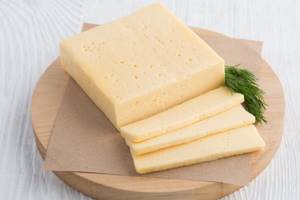
Soy cheese tofu 1.5-4%
Although it is made on the basis of soy milk, tofu is classified as curd cheese, since in color and consistency it resembles low-fat and unsalted feta cheese.
Tofu is rich in high-quality proteins, so it can successfully replace meat. Calcium, present in abundance in this product, has an excellent effect on the bone skeleton, which makes tofu an ideal product for consumption by older people in order to prevent diseases such as osteoporosis.
In addition, 100 grams of tofu cheese contains only 90 calories, so it is recommended to include it in the diet menu.
Many celebrities have replaced dairy products and cheeses with soy in their diet, so many diets have now been developed that involve a reduced consumption of classic cheeses, while tofu is recommended for daily consumption along with foods of plant origin.
A number of nutritionists also claim its healing properties, because it has already been proven that it helps reduce the level of “bad” cholesterol (LDL) in the blood, which helps prevent many cardiovascular diseases.
With what and how to eat? Suitable for miso soup, salads.
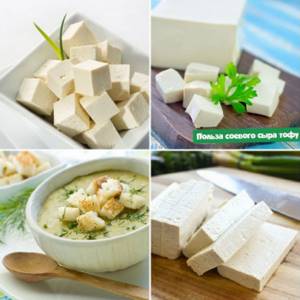
Fresh mozzarella cheese "buffalo" type 18%
Not to be confused with the regular one! Found in the form of white balls soaked in brine, the cheese does not last long. The most delicious one-day mozzarella, but for now you can only try it in Italy.
Buffalo mozzarella is now produced all over the world. Not to be confused with the traditional variety of mozzarella used in pizza. Its fat content is 23%.
With what and how to eat? The best option is with olive oil, ground black pepper, basil and tomatoes.
This cheese can also be quickly marinated in olive oil with herbs, garlic and sun-dried tomatoes and baked.
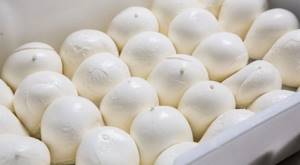
Is suluguni good for weight loss?
This delicacy should be present in the diet, since its benefits, unlike other cheeses, are several times greater. This is due to the fact that it has the lowest fat content. When losing weight, to maintain immunity and saturate the body with vital substances, it is important to eat healthy and natural food that does not contain additional sugar and various flavoring additives. Suluguni is considered an excellent snack, and can also be used before bed, since it does not cause heaviness in the stomach and breaks down quickly. Cheese does not lead to the formation of excess weight and can speed up metabolism, which eliminates the gain of extra pounds.

